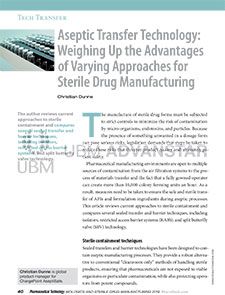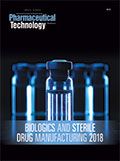Aseptic Transfer Technology: Weighing Up the Advantages of Varying Approaches for Sterile Drug Manufacturing
Choosing the right contamination control platform requires considerable research into what a product needs for an effective process design.

Pharmaceutical manufacturing environments are open to multiple sources of contamination from the air filtration systems to the process of materials transfer and the fact that a fully gowned operator can create more than 10,000 colony forming units an hour. As a result, measures need to be taken to ensure the safe and sterile transfer of APIs and formulation ingredients during aseptic processes. This article reviews current approaches to sterile containment and compares several sealed transfer and barrier techniques, including isolators, restricted access barrier systems (RABS), and split butterfly valve (SBV) technology.
Read this article from Pharmaceutical Technology’s Biologics and Sterile Drug Manufacturing 2018 eBook.
Article Details
Pharmaceutical Technology
eBook: Biologics and Sterile Drug Manufacturing
Vol. 42
May 2018
Pages: 40–43
Citation
When referring to this article, please cite it as C. Dunne, “Aseptic Transfer Technology: Weighing Up the Advantages of Varying Approaches for Sterile Drug Manufacturing,” Pharmaceutical Technology Biologics and Sterile Drug Manufacturing eBook (May 2018).

Drug Solutions Podcast: A Closer Look at mRNA in Oncology and Vaccines
April 30th 2024In this episode fo the Drug Solutions Podcast, etherna’s vice-president of Technology and Innovation, Stefaan De Koker, discusses the merits and challenges of using mRNA as the foundation for therapeutics in oncology as well as for vaccines.